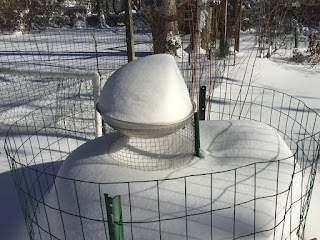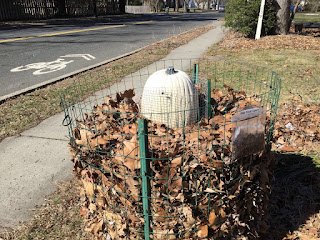This post provides instructions for building a kind of home composter I designed. Called a "Wishing (the Earth) Well," it has a number of nice features, including being reasonably attractive while keeping animals from digging through your food scraps. Follow a few basics, and composting food scraps will be easy, odorless, and satisfying. Most any container on the kitchen counter will do, but we use a stainless steel bucket with lid. Every few days, there's a trip to the composter in the yard. Nature does the rest.
With the suspension of the curbside collection of organics (food scraps and whatever other compostables would fit in the small rollcarts), about 800 Princeton residents who had discovered the satisfaction of keeping food scraps out of the trash are now wondering what to do.
One option for those with a yard is to compost at home. There are lots of composters out there. Those that you can rotate in order to mix the contents seem like a good idea, but I don't know anyone who has gotten them to work well. I've found that the ones that have direct connection to the ground are the most likely to succeed. Moisture, fungi, earthworms, and other decomposers all migrate upward to work their wonders on the composting material.
If you want to keep wild animals out of the compost (some areas of Princeton have rats), here's a design that keeps the food scraps contained in durable metal screening (hardware cloth), while using leaves to keep the foodscraps insulated from temperature extremes and hidden from view. It's called a Wishing (the Earth) Well because it looks like a wishing well but works in reverse, giving nutrients back to the earth rather than pulling water out. No turning or periodic remixing of contents is necessary.
When it's empty, it looks like this, with a circle 3 feet in diameter of green fencing, and a central cylinder of hardware cloth that holds the food scraps.
When packed with leaves around the outside, it looks like this. The leaves insulate and obscure the inner cylinder of foodscraps.
More often, it looks like this, as the composting leaves and food settle.
To get started, you'll need a roll of wire fencing, 3 feet high. See bottom of post for material details and purchase options.
Measure out 10 feet of the 3 foot high fencing. I use a long board to keep the roll of fencing stretched flat. Cut the stubs flush at each end so you don't have wire tips sticking out. Make a circle of the 10 foot length of fencing, overlap the ends a square or two, and use plastic zip ties to tie the ends together. Four should be sufficient. The corral portion is done.
Now for the inner cylinder where the food scraps go. You can see in the background some chicken wire, which is cheaper but not very strong, and not fine enough mesh to keep rodents out. In the foreground is a cylinder cut from a roll of hardware cloth three feet high and 3.5 feet long. I recommend cutting the ends flush so you don't have a bunch of the little metal stubs sticking out.
Make the shape of the cylinder and have the ends overlap an inch or two, then secure with zip ties (5 or so)
The cylinder should work out to be about a foot in diameter. If you have a particular top in mind, make the cylinder small enough in diameter that the lid will fit well and stay on top. Anything flat or bowl-shaped and sufficiently heavy to deter animals will be sufficient. I've used a piece of leftover bluestone, or an old metal bowl with a hole drilled in the bottom so it doesn't collect water, and weighted down with a brick.
For the bottom of the cylinder, cut a square of hardware cloth slightly larger than the circle and bend the corners down. Use a few plastic zip ties to keep it on. It will be pressing against the ground, so just a few zip ties should be sufficient.
The wire components should look like this when done, with whatever critter-proof top you want to use.
(Note: In the photo, the top is an old aluminum bowl I happened to have around. It's slightly larger than the hardware cloth cylinder, so stays on top. I drilled a hole in the bottom of the bowl so water doesn't accumulate, and put a brick in it to discourage raccoons from lifting it off. Another top consists of a square piece of hardware cloth large enough to completely cover the top of the food scrap cylinder, upon which is placed a flat stone, e.g. a paver or small bluestone.)
All that's needed beyond this are 4-foot long stakes--one for the inner cylinder to keep it upright, and a minimum of two for the outer ring.
A hubcap can be put on top, looking surprisingly classy, like a symbol of the sun. It can serve as the top if you don't have animals trying to get in, or can perch atop any other, heavier top you use.
Wire fencing, plastic coated or galvanized, runs $30-40 for 50 feet.
Here are some possibilities:
https://www.homedepot.com/p/Everbilt-3-ft-x-50-ft-14-Gauge-Welded-Wire-308301EB/205960855
https://www.homedepot.com/p/allFENZ-3-ft-x-50-ft-14-Gauge-Green-PVC-Coated-Welded-Wire-YG360502414G/305495538
The 3 foot high hardware cloth is also available in rolls.
The best prices for fencing and hardware cloth require buying more than you need. It's best, though, to have more than one Wishing (the Earth) Well, to provide more capacity in case the food scraps fill up the inner cylinder in the winter when not much composting and settling is going on. You can also prepare one for harvesting by letting its contents rot down into compost while adding the latest organics to the other composter.
Each fall, before accepting a new crop of autumn leaves, the Wishing (the earth) Well yields a wheel barrow full of rich compost, to be spread on the vegetable garden.
Though the leaf portion of the corral was topped off many times with additional leaves, all has decomposed down to what looks like 6 inches of leaves at the bottom. This outer crust of leaves disguises the rich compost underneath that is ready for use. The left tub shows the leaf mold; the right is decomposed kitchen scraps. The fall harvest of compost is ready to spread on the garden beds.
Here you can see that the rodents were not able to get into the foodscraps. Annual emptying is necessary so that tree roots don't have time to invade.
Reassemble and fill with this year's leaves that in turn will be effortlessly composted by next fall. The leaves nicely disguise the inner cylinder of food scraps.
It's so convenient to have leaf corrals discretely integrated into the landscaping here and there, so that leaves don't have to be hauled or blown long distances. In a house, we have discrete containers for trash in nearly every room. Why not have similar convenience in the yard?
Here's a closeup of the compost, soft and spongy, dark and rich. Ah, the rewards of all that non-labor and non-burning of fossil fuels.
One novel way to insure that all the leaves in the leaf corral are moist enough to decompose is to use one of those root feeder rods to poke holes in the pile so the rain can seep in. Better yet, connect a hose to the root feeder and use it to inject some water into the pile.
Leaf corrals can be easily hidden in a backyard corner, but if integrated into the front yard landscaping, they show neighbors and the community that leaves should be treated as a gift to our yards, and not something to be hauled away.
Some tips for using the Wishing (the Earth) Well:
- One thing to keep in mind is that animals such as raccoons may climb up the fencing to try to get to the inner column of food scraps. Though they don't succeed, they bend the wire fencing. More stakes would help, but stiff, springy wire woven around the top of the fencing is working well thus far. (Note: the wire I'm using is some leftover electric deer fencing wire a friend gave me.) Our composter in the front yard doesn't have this problem.
- As mentioned above, make sure the leaves are moist enough to decompose.
- Tree roots will invade from the bottom if the leaf corral is never emptied, which is fine, but if you want to use the compost elsewhere, remove the fencing some day in the fall, rake away the layer of leaves and shovel out the rich inner core of compost created over the summer. Put the fencing back in place and the corral is ready for a new fall harvest of leaves.
- The outer ring of leaves will keep reducing in size. This is good--it shows that the leaves are decomposing--but it also means the inner column of foodwaste will become exposed if one doesn't keep adding leaves or garden clippings to the outer ring.


A white plastic pumpkin found on the curb during a dogwalk served as substitute for the hubcap.
A larger corral, six feet wide and called the OK Leaf Corral, yielded five big tubs of compost ready for incorporation into the garden beds.
The melon plant sprouted from the central cylinder of food scraps, which gets surrounded and hidden by leaves later in the fall, and was able to produce a small melon during those days when summer spends its last heat.
Work with nature, and nature will do most of the work. That's my wish, that more people would discover what a great partner nature can be.
On of the signs on the leaf corral says "Add a leaf and make a wish." I treasure the times I've happened to glance out the window and seen someone stop, read the sign, pick up a nearby leaf and drop it in, then walk off with a new sense of satisfaction. Maybe their wish was personal, or global, or maybe they just simply wished the earth well. We have taken so much from the earth. This leaf corral is a quiet way of saying it can feel really good to start giving back, in small and very large and steady ways.












































